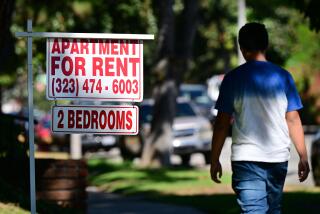Tens of thousands leave Los Angeles County for Inland Empire
Despite staggering rates of unemployment, the Inland Empire continued to pull tens of thousands of people from Los Angeles County during the recession and its aftermath — the nation’s biggest net county-to-county movement from 2007 to 2011 — new Census Bureau estimates reveal.
Roughly 35,000 more people poured into the Inland Empire from Los Angeles County than moved in the opposite direction. The migration occurred even as Riverside and San Bernardino counties lost some 144,000 jobs. The people who moved included rich and poor and Angelenos across educational levels, according to the newly released Census Bureau estimates.
Experts say the huge gulf in housing costs continued to be a powerful force drawing moving vans eastward. In the last quarter of 2013, the median price for a Los Angeles County home was $449,000, said John Husing, chief economist for the Inland Empire Economic Partnership. In the Inland Empire, it hovered around $260,000, according to his figures.
“People respond to prices,” Husing said. “The difficulty is that people move before the jobs move.”
At the worst point after the downturn, unemployment rates topped 14% in the Inland Empire, well above the California average. The recession did slow the rate of relocation, which was far higher during the boom years before the downturn. Between 2000 and 2006, roughly 300,000 more people relocated from Los Angeles County to Riverside and San Bernardino counties than moved in the opposite direction, according to the Public Policy Institute of California.
The flow of people inland will continue to shape how California plans for transportation, schools and water supplies, said Public Policy Institute of California senior fellow Hans Johnson. “And all these discussions are driven by the fact that this population is moving to find more affordable housing,” he said.
Besides the continued flow to the Inland Empire, roughly 16,000 more people moved from Los Angeles County to Orange County and Kern County than the other way around, the census figures showed.
However, “there are lots of people who see the advantage of moving to L.A.,” USC demographer Dowell Myers pointed out.
Though more people moved from Los Angeles County to the Inland Empire than vice versa, the numbers nonetheless show that tens of thousands of people did move the opposite direction during the downturn. Beyond Southern California, “Los Angeles is a giant pump that pulls in people from other countries and all across America, then recirculates them” to other areas, Myers said.
The new numbers also shed light on who was moving from place to place: People with less education left Los Angeles County for elsewhere in California and the nation at higher rates than did people with more schooling, according to an analysis by Brookings Institution demographer William Frey.
At the same time, the flow of immigrants into Los Angeles County from Asia, Central America and other parts of the globe included some 17,000 people with bachelor’s degrees or more advanced education. The influx from abroad is the only reason Los Angeles County increased its number of residents with college degrees from 2007 to 2011, Frey said.
Times staff writer Ryan Menezes contributed to this report.
More to Read
Start your day right
Sign up for Essential California for news, features and recommendations from the L.A. Times and beyond in your inbox six days a week.
You may occasionally receive promotional content from the Los Angeles Times.






